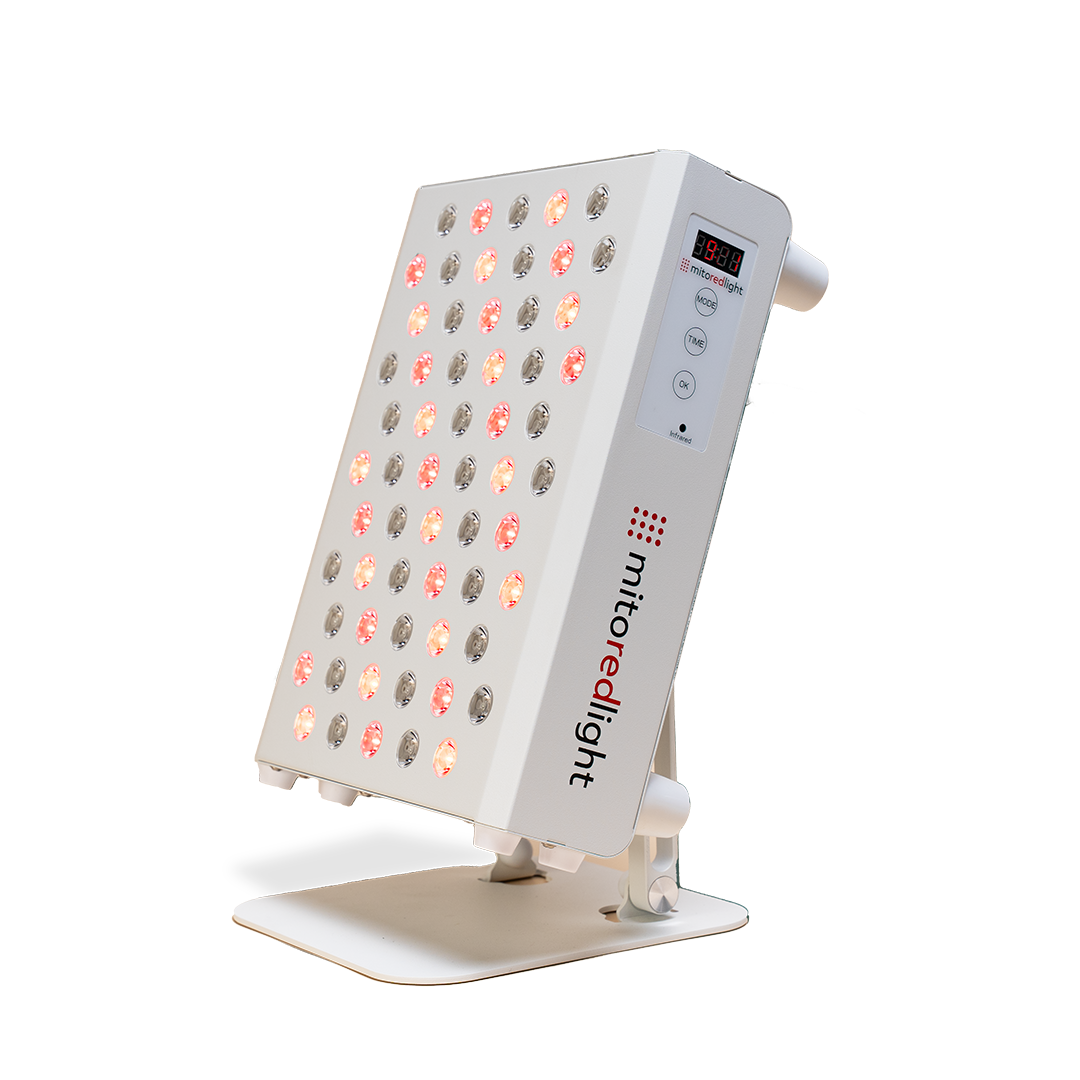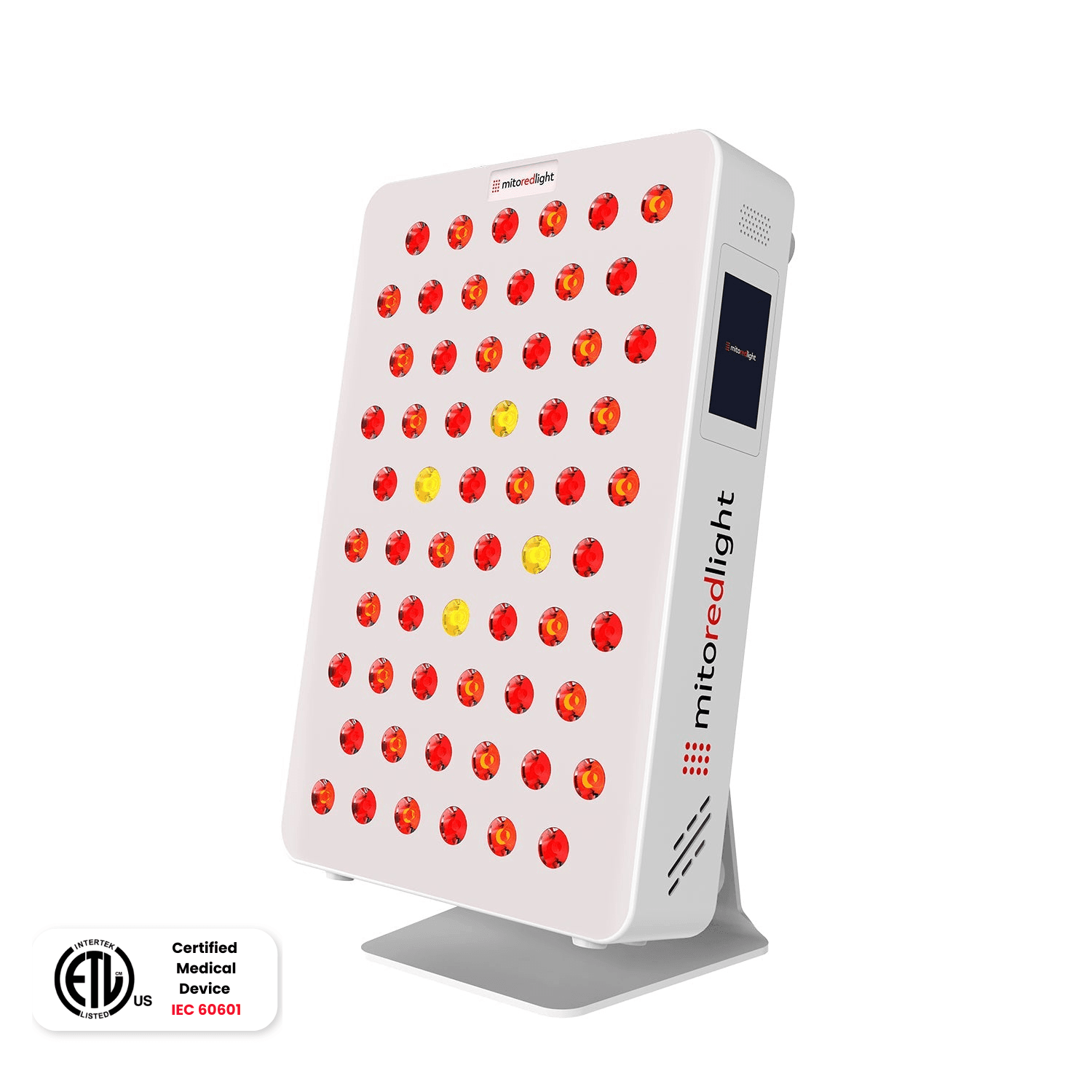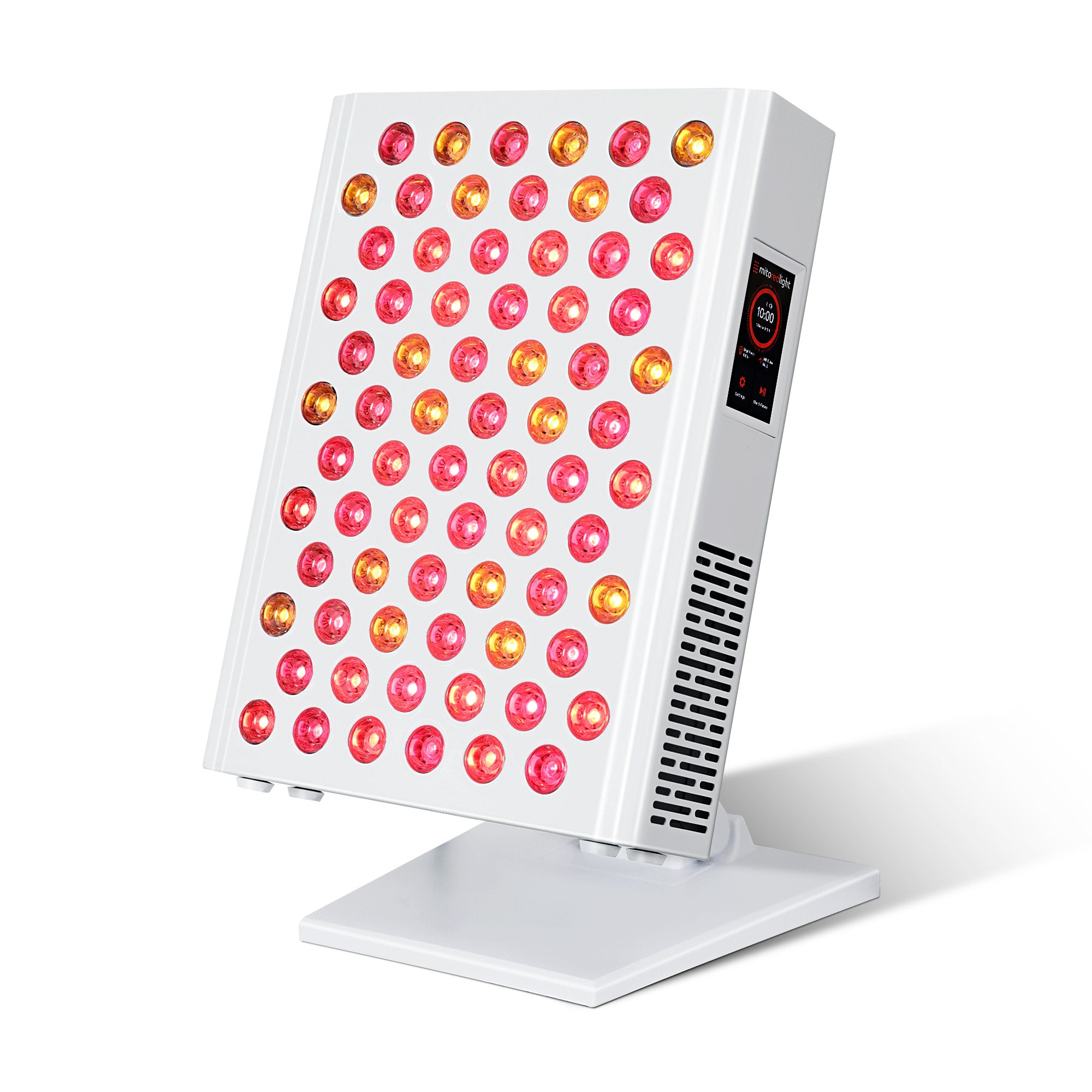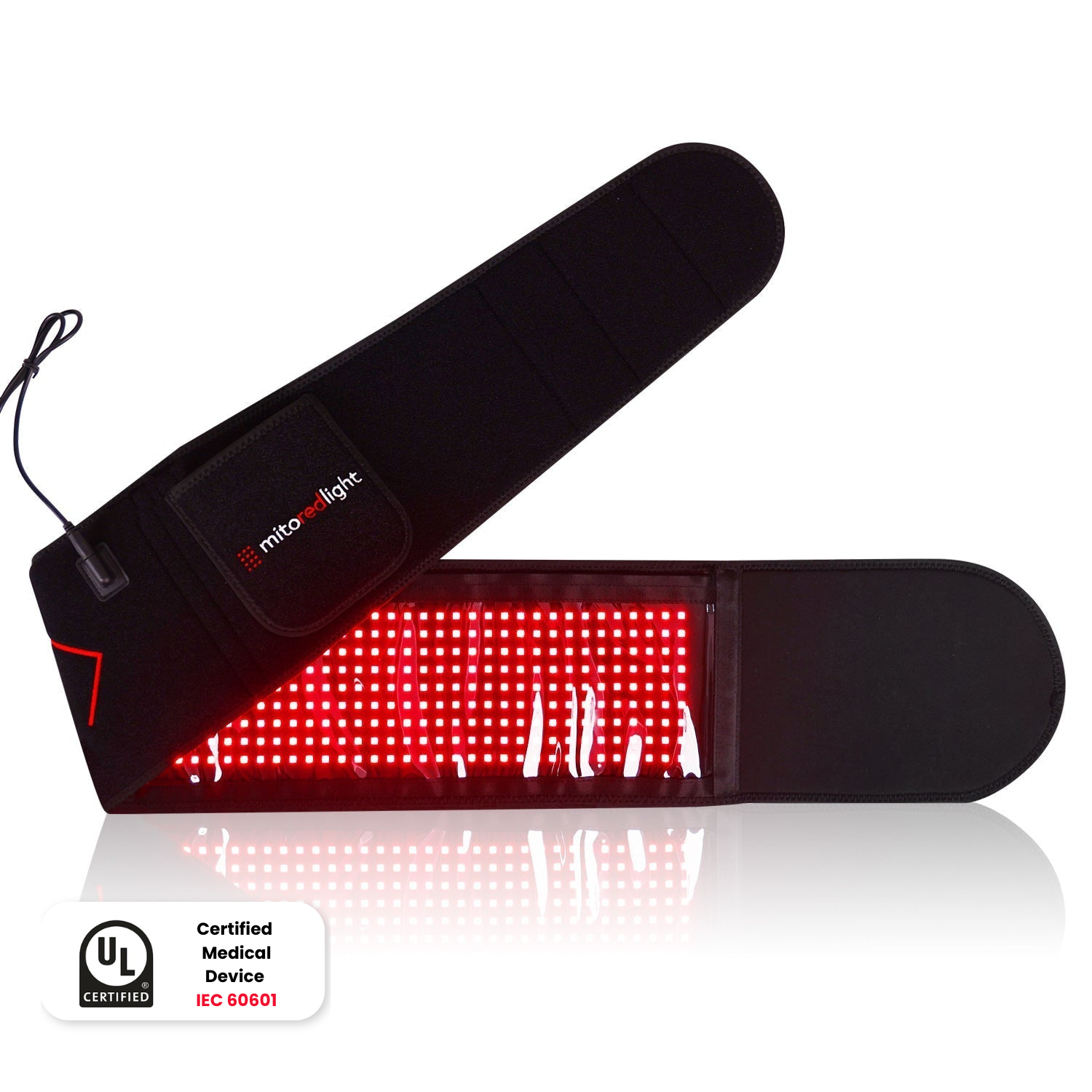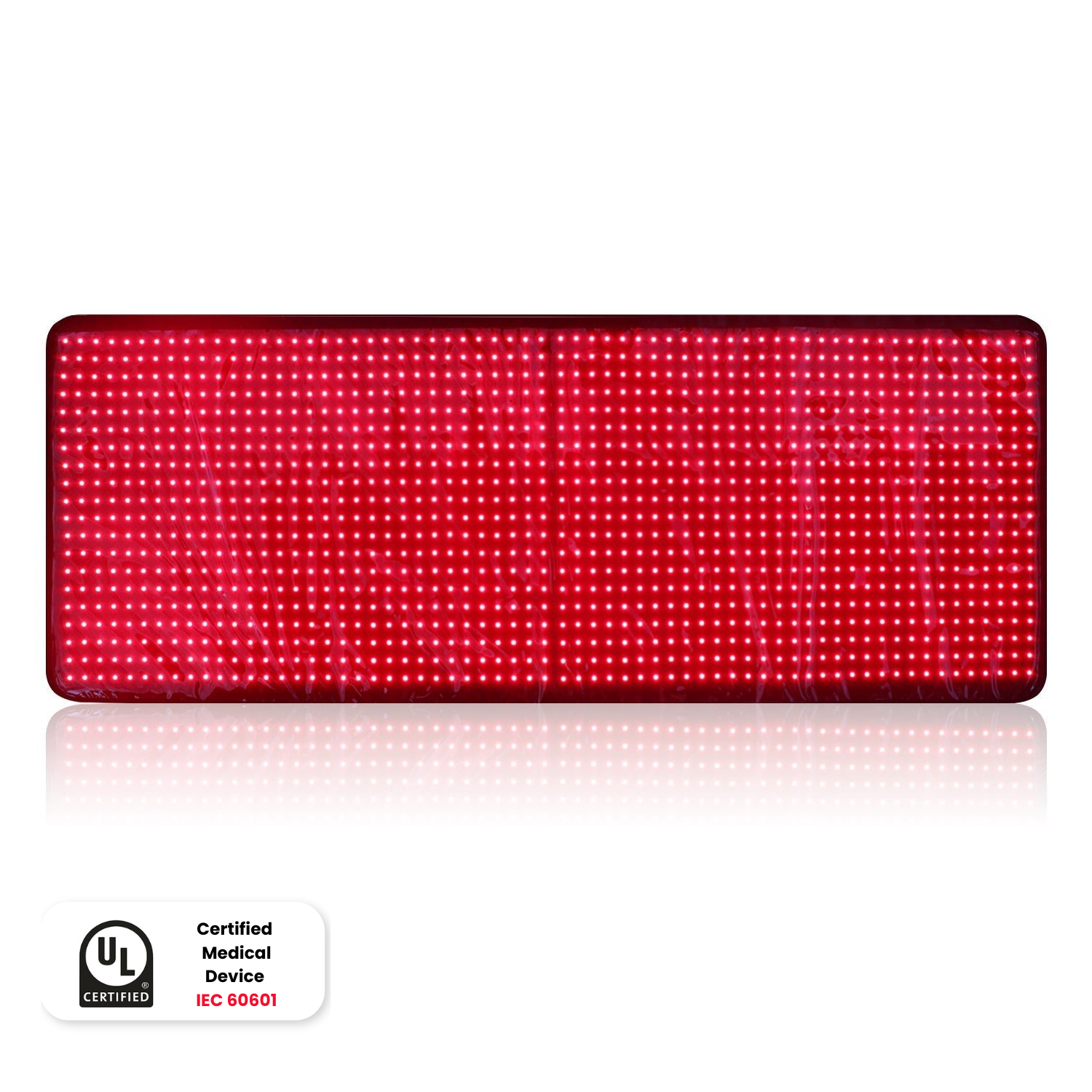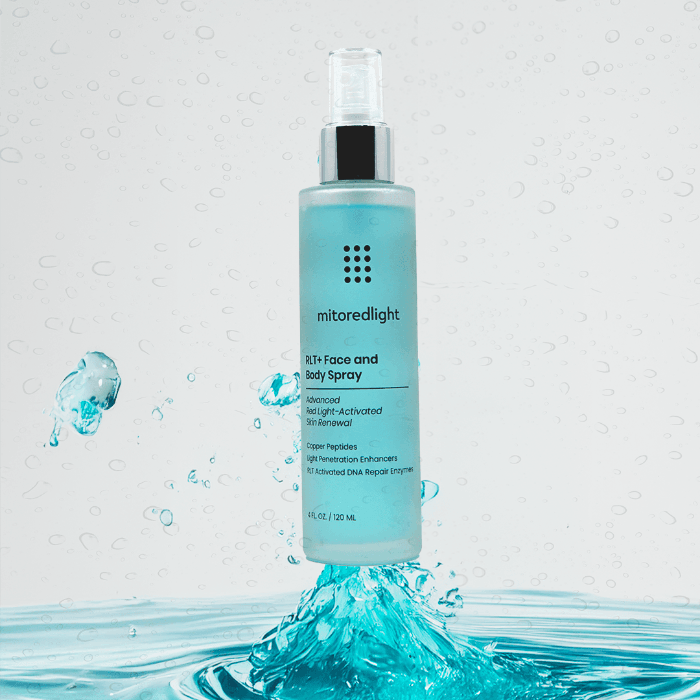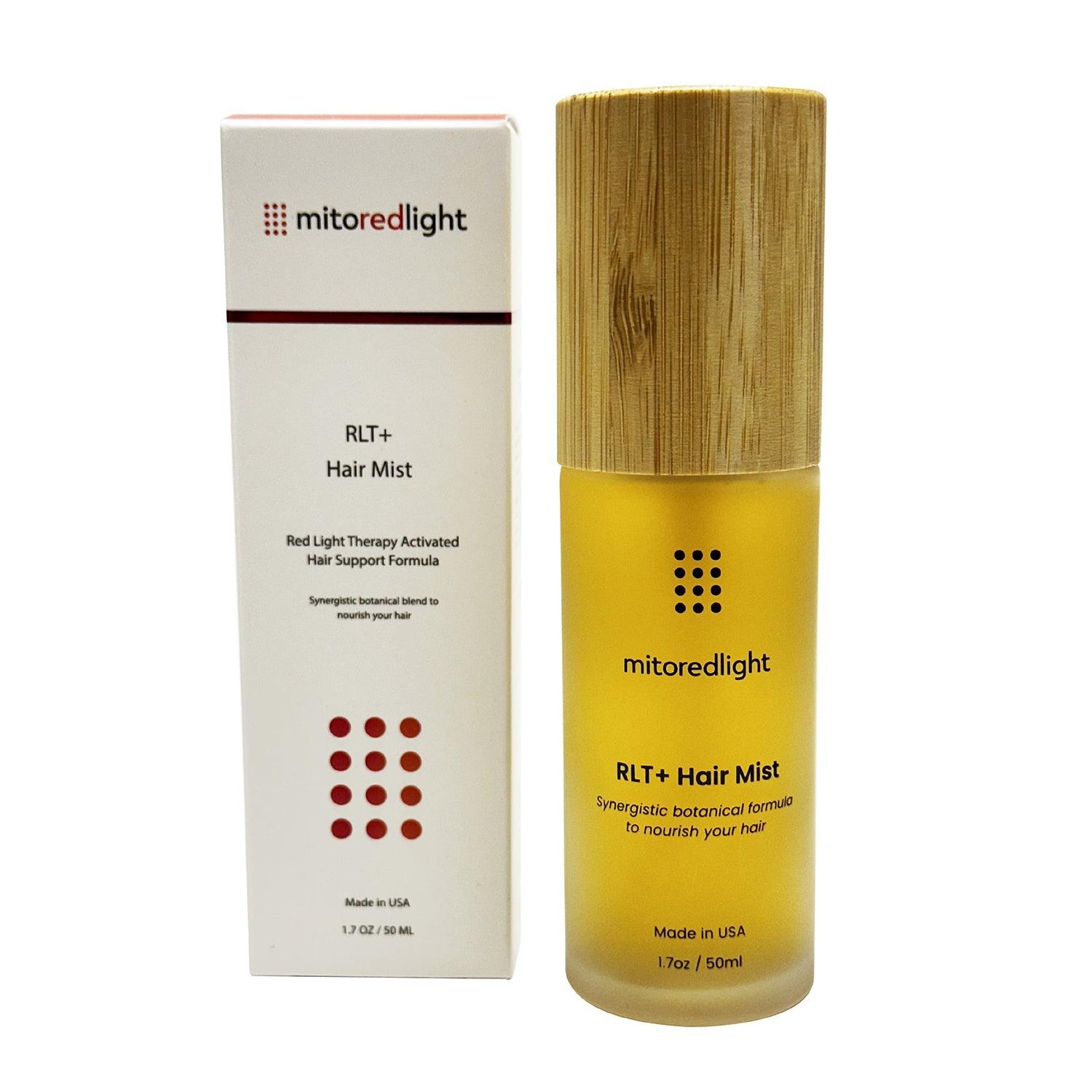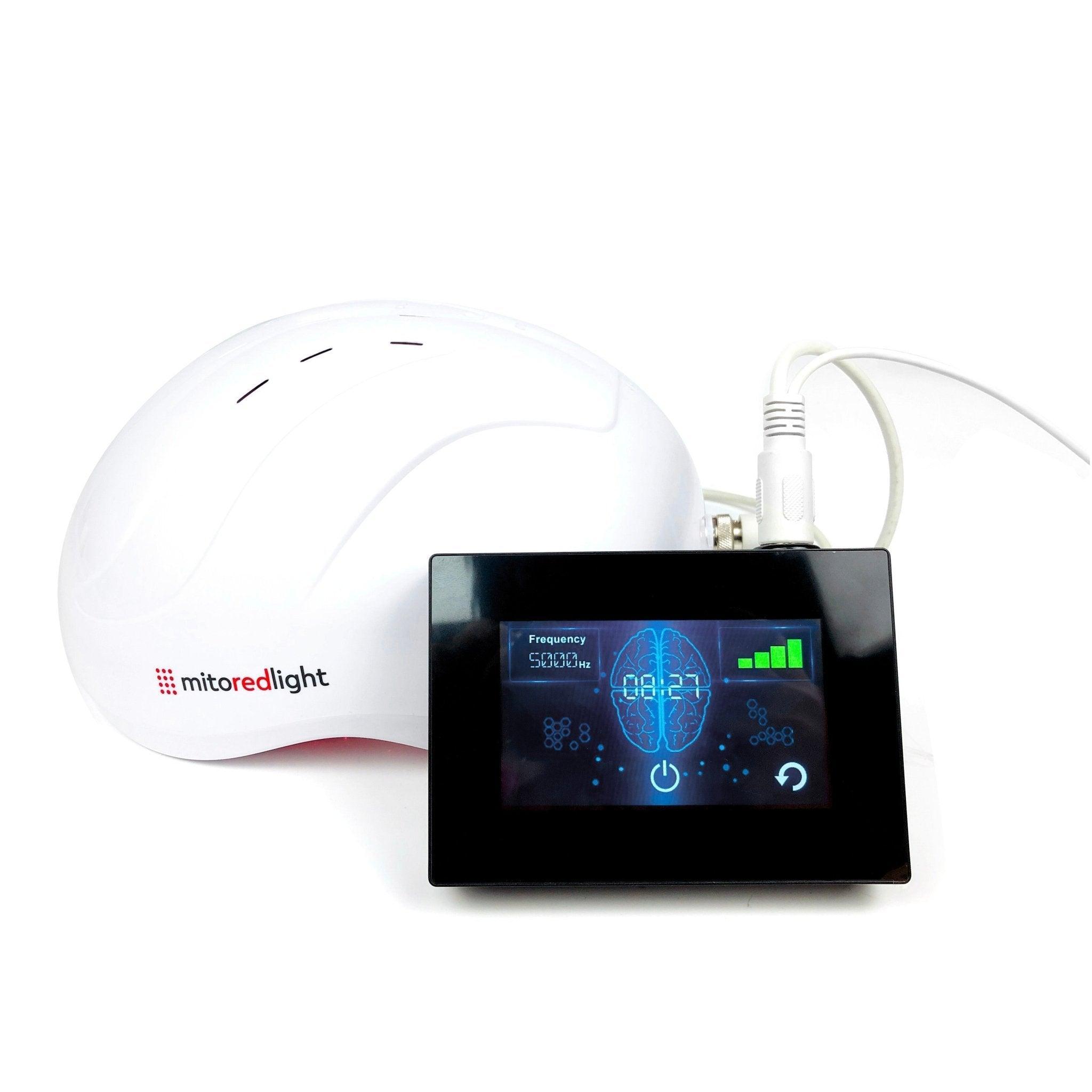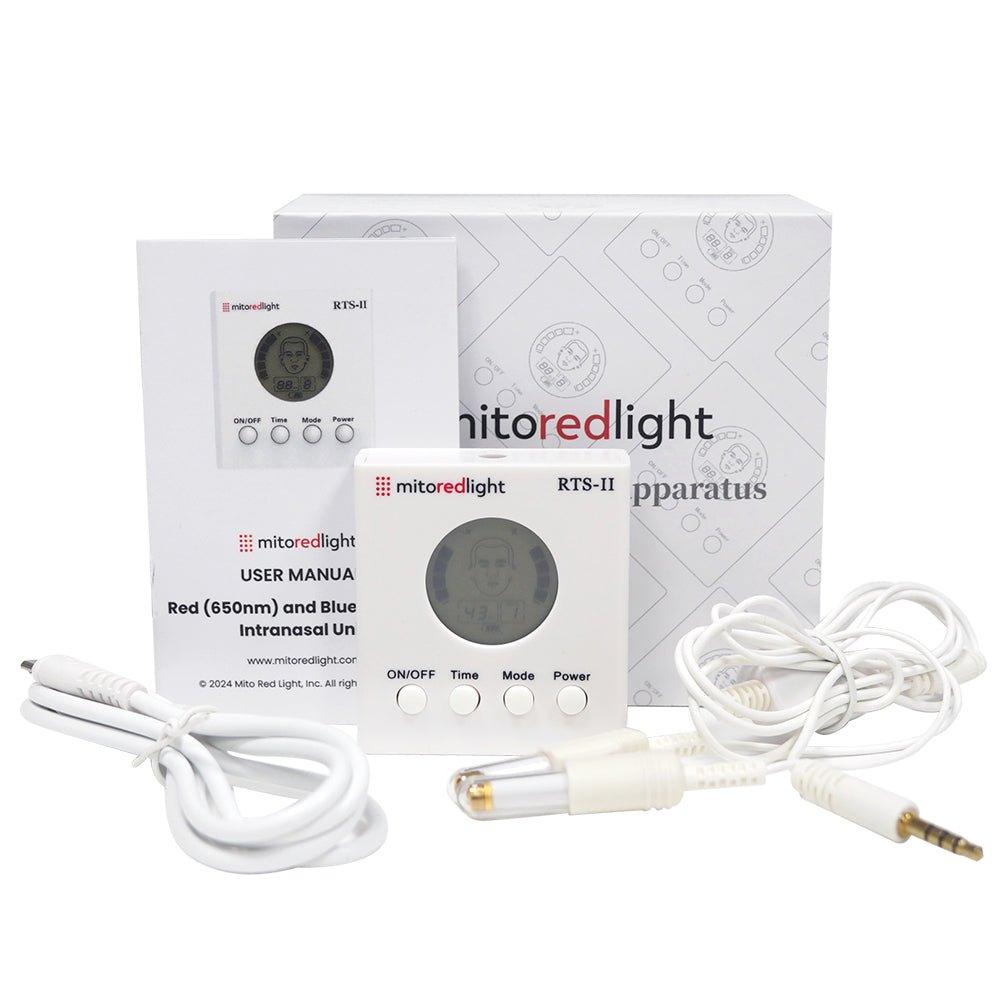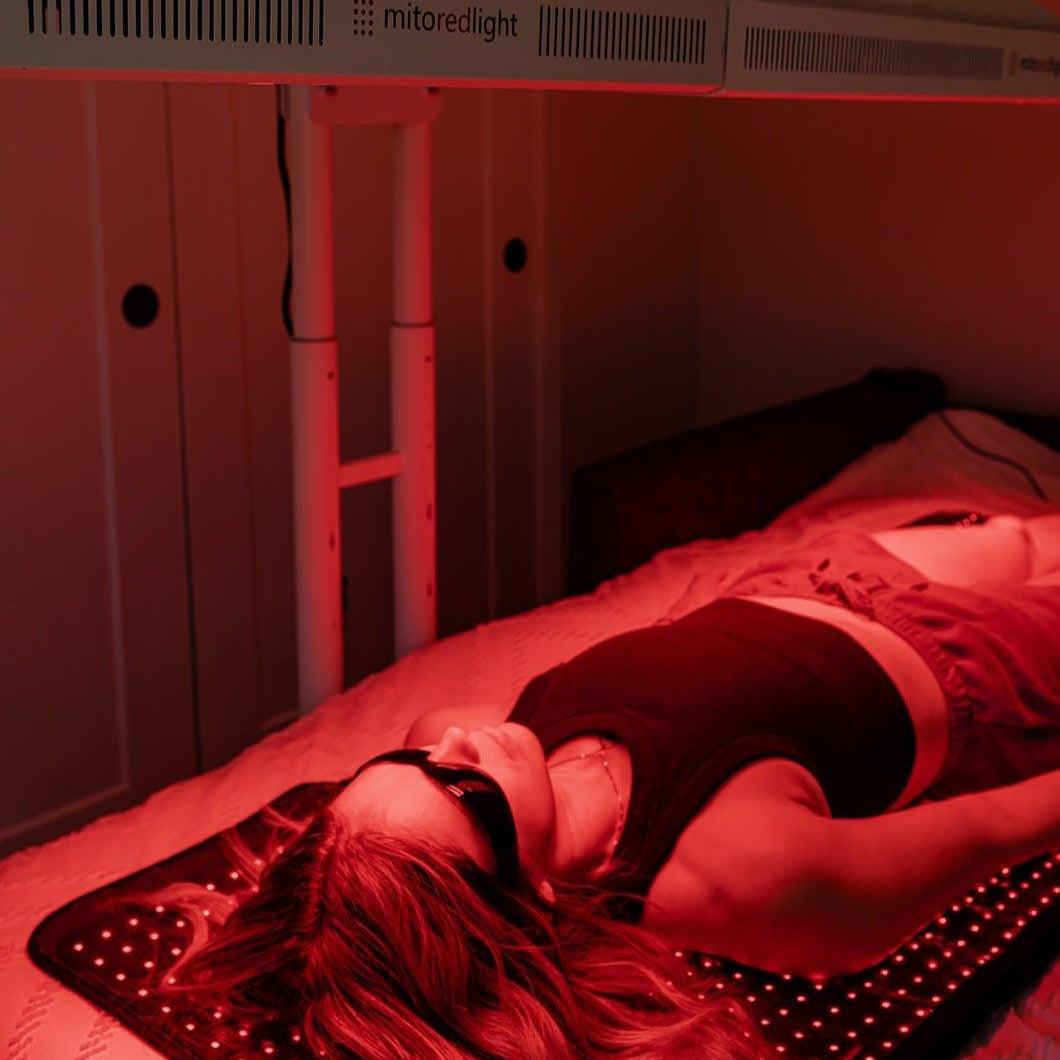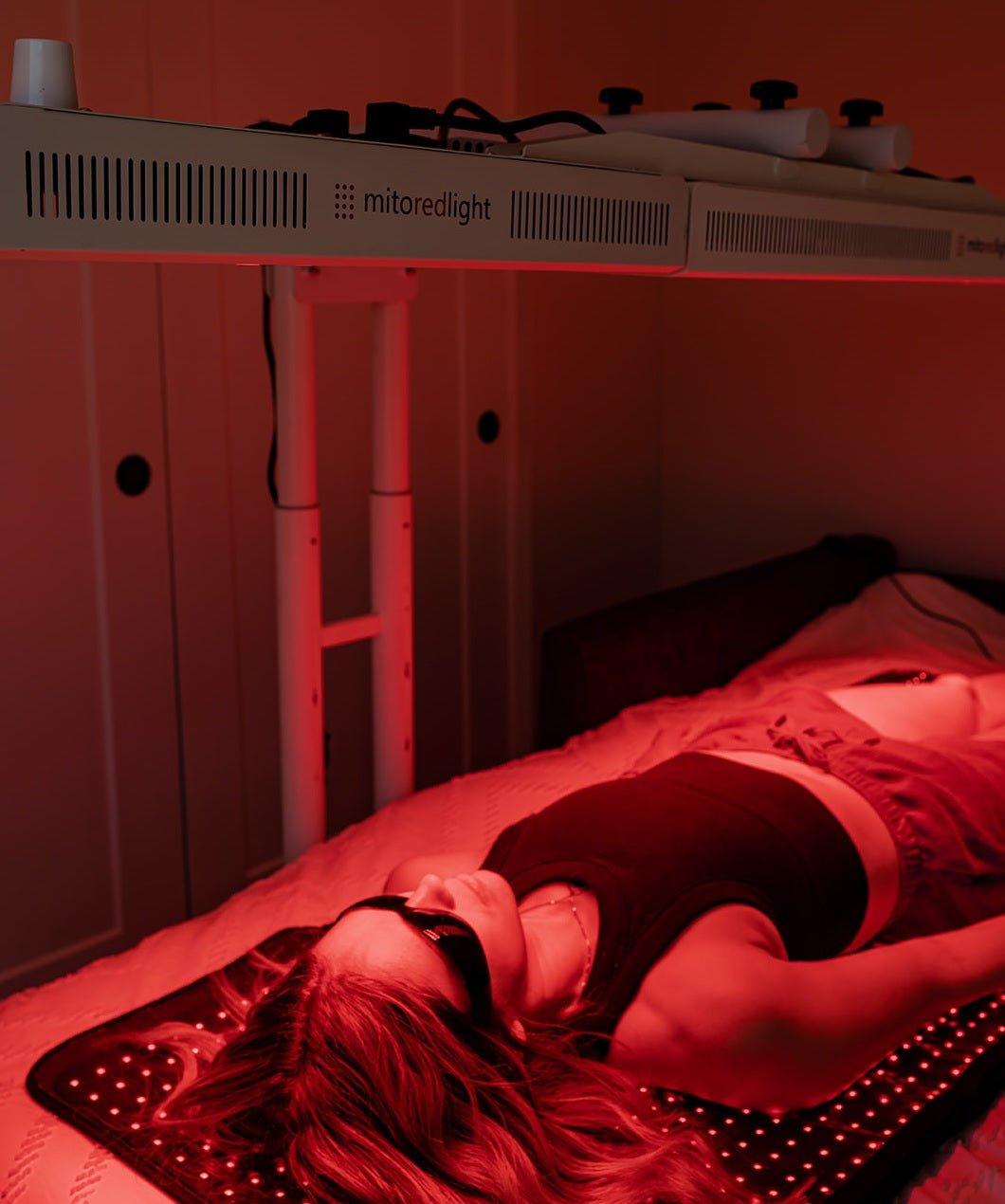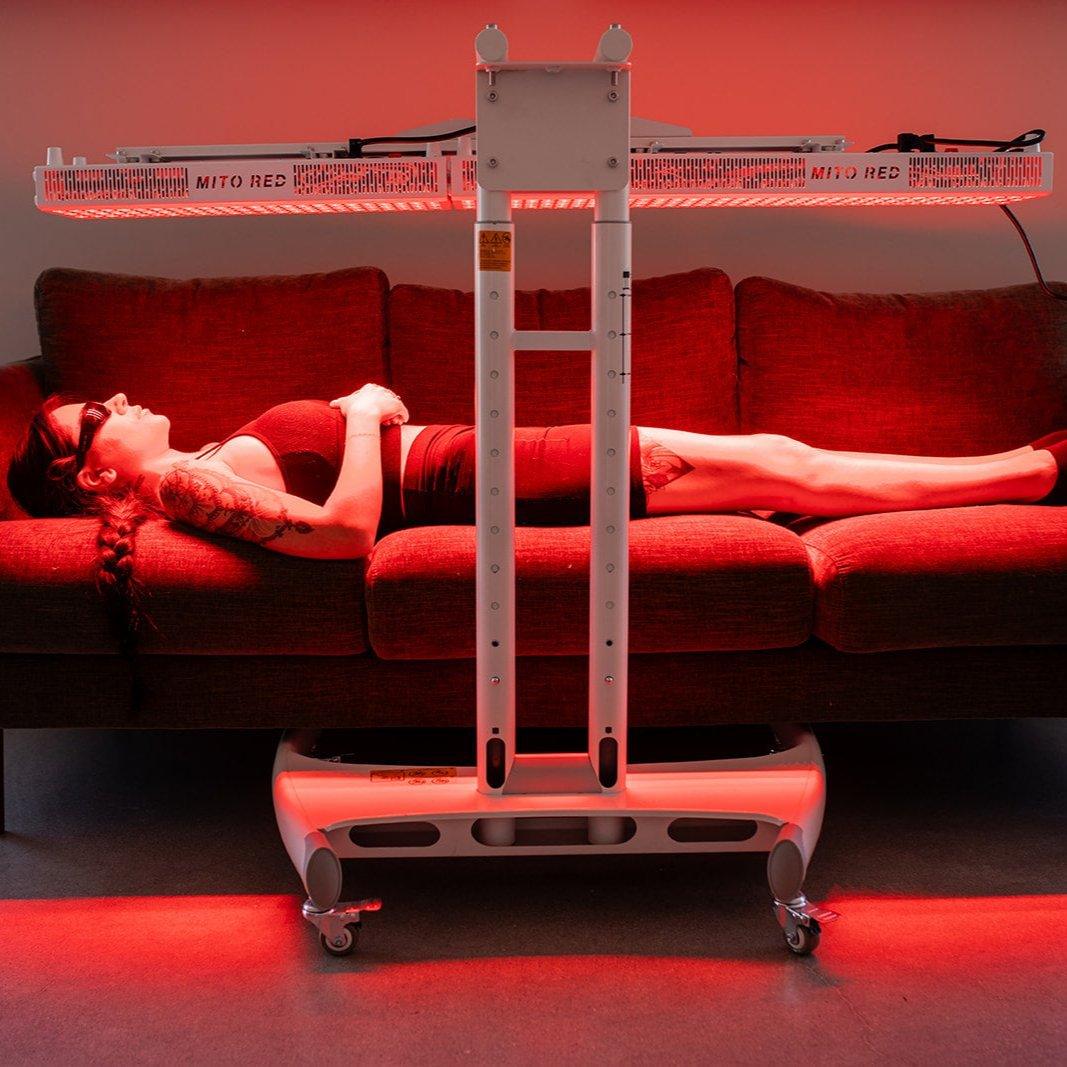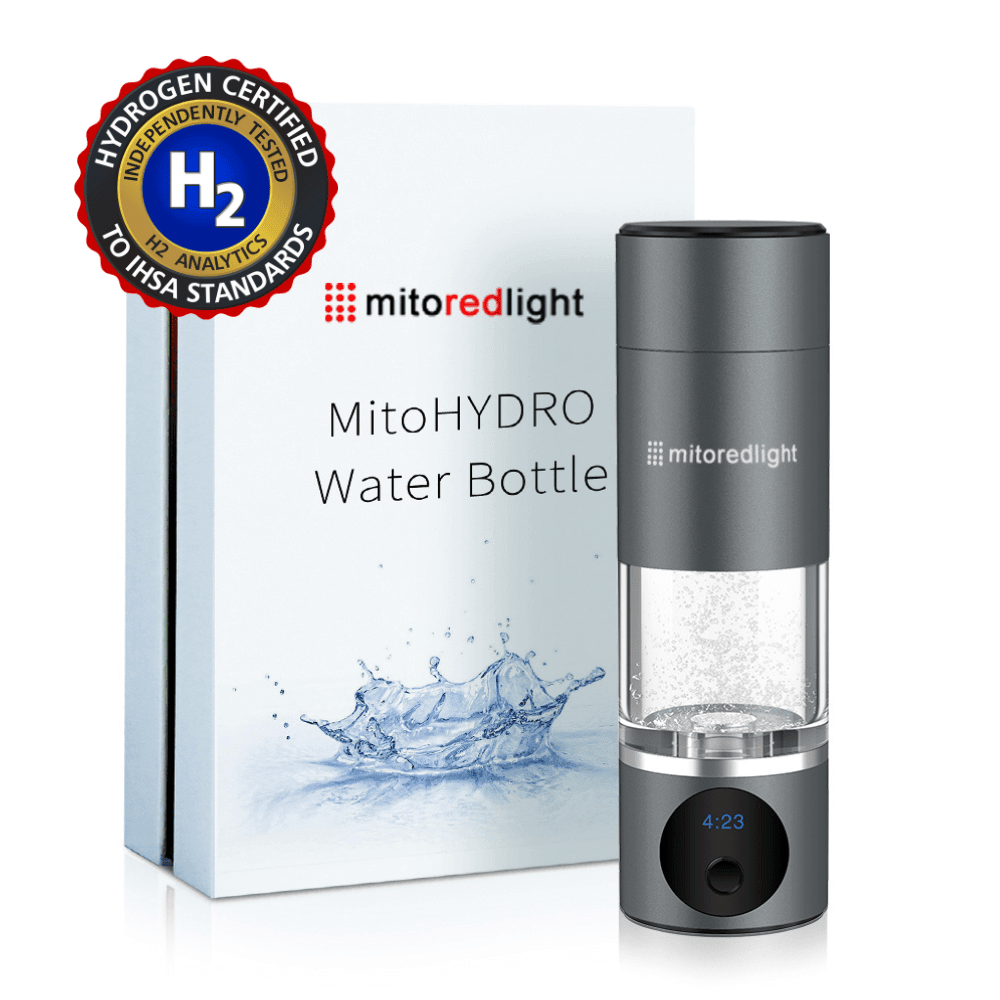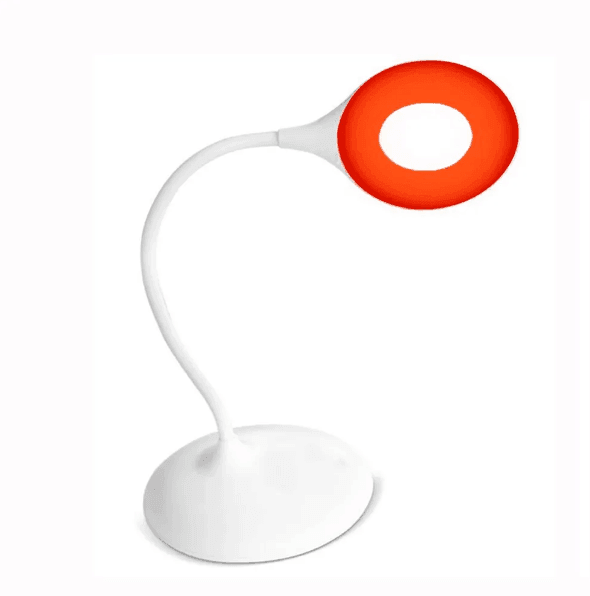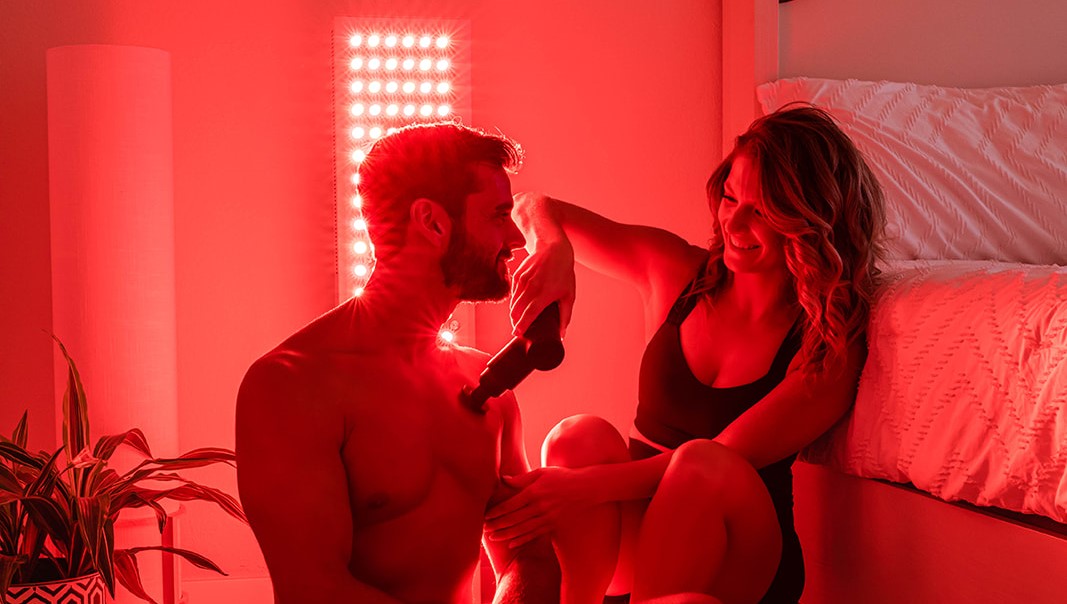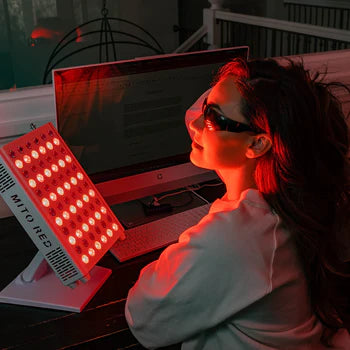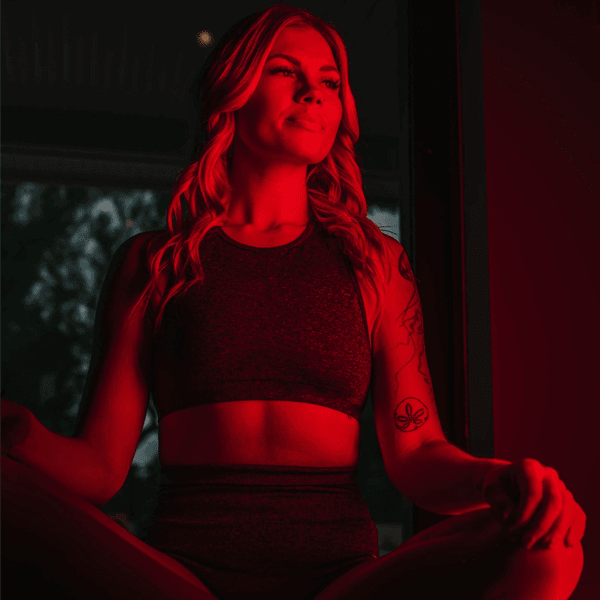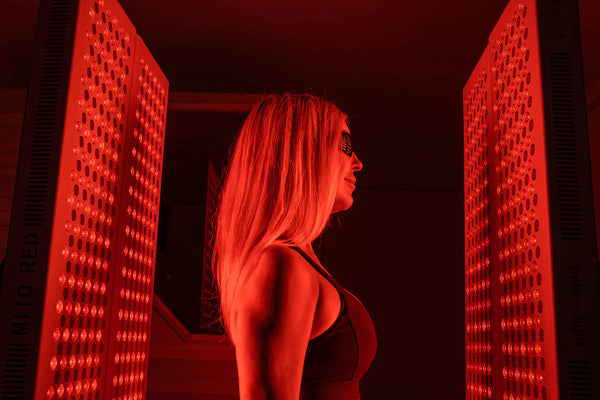DISCLAIMER: Mito Red Light devices are not clinically proven to diagnose, treat, cure, or prevent any medical conditions. Mito Red Light devices are low / risk general wellness devices aimed at affecting the body through supporting cellular function. The scientific studies referenced in this article are for educational and informational purposes only and are meant to educate the reader on the exciting and growing field of phototherapy. To see a list of precautionary warnings and contraindications, click here.
Biohacking with White Light Therapy in your Ears
Authored By Benjamin Caleb Williams, RN, BA, TCRN, CEN
Summary:
Modern lifestyles often disrupt our natural circadian rhythms, leading to sleep issues, low energy, and mood imbalances. Bright light therapy, particularly innovative in-ear applications, offers a promising solution to realign these internal clocks. The circadian rhythm, governed by the suprachiasmatic nucleus (SCN) and primarily influenced by light, regulates crucial functions like sleep, hormones, and metabolism. Disruptions from artificial light, irregular schedules, and reduced sunlight exposure can negatively impact health. Bright light therapy, traditionally applied through the eyes, mimics natural daylight to regulate melatonin and cortisol, improving sleep, mood, and alertness. Emerging in-ear devices offer a convenient alternative by delivering light directly to the ear canal, potentially influencing brain activity related to these functions. Strategically using bright light therapy, especially in the morning, is a powerful biohacking tool to optimize circadian health and overall well-being
Key Takeaways:
-
The circadian rhythm regulates sleep, energy, and metabolism, but modern lifestyles and artificial lighting often disrupt its natural balance.
-
Bright light therapy is a proven method for resetting the circadian rhythm by influencing melatonin and cortisol production.
-
In-ear bright light therapy is an emerging technique that may help regulate the body's internal clock by delivering light through the ear canal.
-
Studies suggest that bright light therapy, even when applied via the ear, can improve sleep quality, mood, and cognitive function by mimicking natural sunlight exposure.
-
Bright light therapy is widely used to combat seasonal affective disorder (SAD), jet lag, shift work fatigue, and general sleep disturbances.
-
Choosing the right bright light therapy device and using it consistently and strategically can enhance wakefulness, boost mood, and optimize overall well-being.
In our fast-paced, screen-lit world, many people struggle with disrupted sleep, low energy levels, and mood imbalances, often failing to realize that these issues stem from a misaligned circadian rhythm. Our bodies are designed to function in sync with natural light cycles, but modern lifestyles have led to an increasing disconnection from this ancient biological rhythm. Light therapy, a well-researched wellness technology, offers a promising way to restore balance.
Among the innovative applications of bright light therapy, in-ear treatments are gaining increased attention for their ability to influence the body’s internal clock. By delivering light directly into the ear canal, this approach may support sleep, mood, and overall well-being. This article explores how circadian rhythms function, how they can become disrupted, and how bright light therapy, especially in-ear treatments, could serve as an effective biohacking tool for optimizing health.
Understanding the Circadian Rhythm and Its Impact on Health
The circadian rhythm is a biological cycle that governs numerous physiological processes over a 24-hour period. This internal clock plays a vital role in regulating sleep, hormone release, metabolism, and even immune function [1].
When properly aligned, this natural rhythm promotes restorative sleep, mental clarity, and optimal energy levels. However, when disrupted, it can contribute to insomnia, fatigue, mood disorders, and a range of chronic health conditions. Understanding how the circadian rhythm functions and how it affects health is the first step in learning how to optimize it.
What Is the Circadian Rhythm?
At its core, the circadian rhythm is the body’s internal timekeeping system, designed to regulate cycles of sleep and wakefulness in response to environmental cues, primarily light and darkness. This rhythm is controlled by the suprachiasmatic nucleus (SCN), a cluster of nerve cells located in the hypothalamus, deep inside your brain. The SCN acts as a master clock, receiving signals from the eyes and adjusting bodily functions accordingly.
Light exposure plays the dominant role in shaping this rhythm. Natural sunlight in the morning signals the body to wake up and become alert, bright light during the day helps to maintain alertness, and the absence of light in the evening prompts the release of melatonin, the hormone responsible for inducing sleep. Exposure to artificial light, particularly blue light from screens and indoor lighting, can interfere with this process, leading to disrupted sleep patterns and long-term health consequences.
The Body’s Internal Clock and Its Regulation
The body’s internal clock operates through a complex network of biological processes that respond to both internal and external signals. While light is the most significant factor influencing circadian rhythms, other environmental and lifestyle factors also play a role. Temperature fluctuations, meal timing, and physical activity levels all contribute to keeping the body's rhythm in sync.
Sleep cycle regulation is maintained through a series of feedback loops involving hormones such as melatonin and cortisol [2]. Melatonin, often referred to as the “sleep hormone,” rises in response to darkness and signals the body that it is time to rest. Conversely, cortisol, which helps with alertness and energy production, follows an opposing cycle, peaking in the morning to encourage wakefulness. A well-functioning circadian system ensures a smooth transition between these states, supporting overall health and vitality.
Key Functions Affected by Circadian Rhythm
The circadian rhythm is responsible for orchestrating a wide range of biological functions that influence physical and mental well-being. When the body’s internal clock is aligned with natural cycles, these functions operate efficiently, promoting optimal health. However, when the rhythm is disrupted, various aspects of health can suffer.
Some of the key processes influenced by the circadian rhythm include:
-
Sleep regulation - A properly timed circadian rhythm ensures deep, restorative sleep, while a misaligned rhythm can lead to insomnia and fatigue.
-
Hormonal balance - The release of hormones such as melatonin, cortisol, and growth hormone is synchronized with the body’s natural cycles.
-
Metabolism and digestion - Meal timing affects glucose regulation, digestion, and overall metabolic efficiency.
-
Cognitive function - The circadian rhythm and the healthy sleep cycles it promotes influences memory, concentration, and mood stability.
-
Immune system function - A well-regulated circadian rhythm and the good sleep cycle that it promotes helps strengthen immune defenses against infections and inflammation.
When these functions are disrupted, individuals may experience sleep disturbances, mood imbalances, metabolic issues, and even increased susceptibility to illness. Maintaining a healthy circadian rhythm is crucial for long-term well-being.
Common Disruptions to Circadian Rhythm
Despite being hardwired into our biology, the circadian rhythm is surprisingly easy to disrupt. In the modern world, it is constantly under assault from artificial lighting, irregular schedules, stress, and travel. These disruptions can lead to chronic sleep disturbances, hormonal imbalances, and metabolic dysregulation [3].
While our bodies are resilient, repeated disruptions to the circadian rhythm can contribute to long-term health issues. Understanding these disruptions and how they impact well-being is crucial for taking proactive steps toward restoring balance.
How Modern Lifestyles Disrupt Natural Rhythms
Modern life presents countless challenges to maintaining a naturally regulated circadian rhythm. The widespread use of artificial lighting, excessive screen time, and high-stress work environments often override the natural cues our bodies rely on. Late-night scrolling, shift work, and erratic meal schedules can all also play a role in misaligning the body's internal clock.
Some of the most common ways modern lifestyles disrupt circadian rhythms include:
-
Artificial light exposure at night - Blue light from screens and LED lighting suppresses melatonin production, delaying sleep onset and affecting sleep quality.
-
Inconsistent sleep schedules - Irregular sleep-wake cycles from social obligations, work, or travel can confuse the body's internal clock. Jet lag is a particularly extreme type of disruption that can be particularly impactful
-
High stress levels - Chronic stress and anxiety keep cortisol levels elevated, interfering with the natural sleep-wake cycle.
-
Poor dietary habits - Eating late at night or skipping meals can throw off metabolic rhythms and digestive efficiency.
-
Lack of natural sunlight exposure - Limited outdoor time reduces the body's ability to synchronize with natural light cycles.
Addressing these disruptions requires conscious lifestyle adjustments. Even small changes, such as reducing blue light exposure before bed or maintaining a regular meal schedule, can make a significant difference in circadian health.
Jet Lag and the Circadian System
Jet lag is a more extreme example of how external factors can throw the circadian rhythm off balance. When traveling across multiple time zones, the body’s internal clock struggles to adjust to the new daylight schedule. This misalignment leads to symptoms such as fatigue, difficulty concentrating, digestive discomfort, and poor sleep quality [4].
The severity of jet lag depends on factors such as the number of time zones crossed and the direction of travel. Traveling east tends to cause more severe symptoms, as the body must shorten its day rather than extend it. While the body will naturally adjust over time, the process can take several days. Strategies such as light exposure, meal timing, and light therapy can help expedite circadian realignment.
Seasonal Affective Disorder (SAD) and Light Deficiency
Seasonal Affective Disorder (SAD) is a mood disorder that typically occurs during the fall and winter months when daylight hours are shorter [5]. Reduced sunlight exposure during these seasons can interfere with the body's circadian rhythm, leading to disruptions in melatonin and serotonin production. People with SAD often experience symptoms such as fatigue, low mood, irritability, and difficulty concentrating.
Light therapy, especially using bright white light, has been widely studied as a treatment for SAD, as it helps regulate circadian signals and hormone production. Exposure to specific wavelengths of light, particularly in the morning, can improve mood, increase energy levels, and promote better sleep.
22 Tips for a Healthy Circadian Rhythm
A well-regulated circadian rhythm is essential for optimal sleep, energy levels, and overall well-being. While modern lifestyles often disrupt this natural cycle, there are numerous strategies to realign your body's internal clock and enhance its function. By implementing small, consistent changes, you can create a lifestyle that supports your circadian health.
Here are 22 actionable tips to help maintain a healthy circadian rhythm:
-
Wake up at the same time every day, even on weekends, to reinforce your body's internal clock.
-
Expose yourself to natural sunlight within 30 minutes of waking up to signal wakefulness and suppress melatonin. Sunrise or sunset “low solar angle” sunlight is particularly important in setting our circadian rhythms.
-
Avoid blue light exposure in the evening, particularly from screens, as it disrupts melatonin production. While a blue light filter can help, avoid screens completely is best if possible.
-
Use red light therapy in the evening to support relaxation and natural melatonin release.
-
Follow a consistent bedtime schedule, going to bed and waking up at the same time daily.
-
Limit caffeine intake in the afternoon and evening, as it can delay sleep onset.
-
Exercise regularly, but avoid intense workouts close to bedtime, as they can spike cortisol.
-
Eat meals at regular intervals to support metabolic rhythms and energy balance.
-
Avoid eating large meals late at night, which can disrupt digestion and sleep quality.
-
Dim lights in the evening to help your body transition into a sleep-ready state. Using orange or red lights in the evening can also be helpful, as these lights lack the blue light that keeps you awake.
-
Use blackout curtains or an eye mask to create a dark sleep environment.
-
Limit alcohol consumption, as it can interfere with REM sleep cycles and keep you from sleeping soundly, even though it may make it easier to fall asleep.
-
Reduce stress with meditation, prayer, or deep breathing exercises to keep cortisol levels balanced.
-
Maintain a cool bedroom temperature (around 65°F or 18°C) for optimal sleep.
-
Incorporate a bedtime routine, such as reading or gentle stretching, to signal relaxation and prepare your body for sleep.
-
Stay hydrated during the day, but limit fluids before bed to prevent nighttime awakenings.
-
Avoid using electronic devices in bed, as they can associate your sleeping space with wakefulness.
-
Use aromatherapy with calming scents, like lavender, as you are going to sleep to encourage relaxation.
-
Limit naps to 20–30 minutes and avoid napping late in the day. Avoiding naps altogether is ideal
-
Maintain a clutter-free sleep environment to promote relaxation and comfort.
-
Expose yourself to bright, natural light in the day to help keep you awake and alert.
-
Consider seeing a sleep specialist if you are having issues getting restful, restorative sleep. Sometimes hidden conditions, like sleep apnea, can keep you from getting good sleep, even if you are doing everything right.
By making intentional choices each day, you can reinforce a strong, healthy circadian rhythm. Over time, these small habits compound, leading to improved sleep, mood, and overall well-being. Light therapy can be an important part of these habits, contributing to your long-term success.
The Science Behind Bright Light Therapy
Bright light therapy is a well-established and scientifically validated method for regulating the body’s circadian rhythm and improving overall health. Unlike red light therapy, which primarily works at the mitochondrial level to enhance cellular function, bright light therapy directly impacts the brain’s sleep-wake cycle by influencing hormone production and neurotransmitter activity. It is widely used to improve alertness, mood, and sleep patterns by mimicking natural sunlight exposure and stimulating the body’s natural circadian signals.
By integrating bright light therapy into daily routines, individuals can optimize their internal clock, helping to combat fatigue, seasonal depression, jet lag, and sleep disturbances. When applied correctly, bright light therapy serves as a powerful tool for circadian biohacking, enhancing both physical and mental well-being.
How Does Bright Light Therapy Work?
Bright light therapy works by exposing the body — primarily the eyes or, in newer applications, the ears — to high-intensity light that mimics natural daylight. This exposure stimulates specialized photoreceptors called intrinsically photosensitive retinal ganglion cells (ipRGCs) in the eyes or potentially in light-sensitive areas in the ears, sending signals to the suprachiasmatic nucleus (SCN) in the hypothalamus, the master clock that regulates the body’s circadian rhythm.
When the SCN receives bright light signals, it triggers a cascade of biological processes, including:
-
Suppression of melatonin production in the morning, increasing wakefulness and energy.
-
Regulation of serotonin and dopamine, neurotransmitters that influence mood, focus, and emotional well-being.
-
Activation of cortisol at the right times to promote alertness and cognitive performance.
-
Adjustment of the body’s internal clock to align with natural daylight cycles, helping individuals adapt to changes in time zones or seasonal shifts.
The effectiveness of bright light therapy depends on factors like timing, intensity, and duration of exposure. Morning exposure to bright light, typically between 2,500 to 10,000 lux for 20 to 30 minutes, is considered the most effective way to reinforce a strong, healthy circadian rhythm.
The Potential of In-Ear Bright Light Therapy
While traditional bright light therapy is applied through the eyes, researchers are exploring in-ear bright light therapy as an alternative method to influence circadian rhythms. The ear canal contains thin, light-sensitive tissues and blood vessels that are closely connected to the brain, potentially allowing light to stimulate neural pathways involved in alertness, mood regulation, and sleep cycles.
There is ample evidence that bright light therapy applied in a visual way can improve wakefulness and provide benefits by stabilizing the circadian rhythm. The studies include:
-
A 2008 study published in the Annals, Academy of Medicine Singapore [6] showed that bright light therapy is effective for treating sleep-wake and circadian misalignment disorders, including insomnia, jet lag, and shift work disorder. The research outlines the best times to use light exposure to optimize wakefulness and realign the circadian rhythm.
-
A 2023 study published in PLOS ONE found that exposure to bright light can significantly improve sleep patterns and mood in older adults [7]. The research suggests that both natural daylight and artificial bright light therapy help regulate the circadian rhythm, particularly in individuals with sleep disturbances and depressive symptoms.
-
A 2021 study published in Frontiers in Physiology [8] demonstrated that using light therapy tailored to an individual’s circadian phase improves sleep quality and cognitive function in Alzheimer’s patients. The study emphasizes that properly timed bright light exposure can enhance both mood and cognitive performance.
-
A 2020 study published in Frontiers in Neuroscience revealed that bright light therapy has a powerful effect on circadian rhythms in individuals with neurodegenerative diseases [9]. The research showed improvements in sleep-wake cycles, hormone regulation, and core body temperature, making it a promising intervention for such conditions.
-
A 2024 study published in Trials found that combining cognitive behavioral therapy for insomnia with bright light therapy can improve sleep and help correct circadian misalignment in young individuals [10]. The study suggests that while therapy alone can enhance sleep quality, adding light therapy is particularly effective for evening-type individuals who struggle with delayed sleep phases.
While bright light therapy is traditionally administered through the eyes, recent research explores delivering this light via the ear canal. This method, often known as transcranial bright light therapy, is still in early stages of investigation, with scientists examining its effects on brain activity, mood, and sleep. The following studies explore the potential benefits of this innovative technique:
-
A 2014 study published in BMC Psychiatry found that transcranial bright light therapy through the ear canal may help alleviate symptoms of seasonal affective disorder (SAD) [11]. This randomized, double-blind study showed that participants receiving ear-administered light therapy experienced improvements in mood and energy levels, suggesting this delivery method is valid.
-
A 2020 study in Work examined how transcranial bright light therapy affects sleep and mood in overworked employees [12]. The study found that those who received light exposure via the ear canal reported better sleep quality and lower depressive symptoms. These findings suggest potential workplace applications for reducing stress-related fatigue and improving overall well-being.
-
Another 2014 study in BMC Psychiatry further explored dose-response effects of transcranial bright light therapy in individuals with seasonal affective disorder [13]. Results reinforced that light administered via the ear canal could have a positive impact on mood and energy levels, supporting the idea that alternative light exposure pathways might influence brain function.
-
A conflicting study published in 2014 in Chronobiology International investigated whether transcranial bright light exposure suppresses melatonin production. Unlike traditional bright light therapy, light exposure through the ear canal did not affect nighttime melatonin levels [14], suggesting conflicting evidence on the efficacy of this delivery method.
-
A 2016 study in PLOS ONE revealed that the human brain responds to transcranial light exposure [15]. Using neuroimaging techniques, researchers found that light administered outside of the eyes, including via the ear canal, activated brain regions involved in emotional and cognitive processing. This suggests non-retinal light exposure could have broader effects. This study also demonstrated conclusively using cadavers light light applied via the ear canal does reach the brainstem.
Although more studies are needed to fully validate the efficacy of in-ear bright light therapy, early findings suggest it could be a convenient and practical alternative to traditional light therapy, especially for those who struggle with bright light sensitivity through the eyes.
Why People Use Bright Light Therapy
Bright light therapy is gaining popularity among biohackers, health enthusiasts, and medical professionals for its proven ability to regulate mood, sleep, and energy levels.
Here are some of the most common reasons people turn to bright light therapy:
-
Improved Sleep Quality – Morning light exposure helps regulate melatonin, making it easier to fall asleep and wake up naturally.
-
Enhanced Mood and Mental Clarity – Light therapy is clinically proven to help reduce symptoms of depression and seasonal affective disorder (SAD).
-
Increased Alertness and Focus – Bright light exposure improves cognitive function, reaction time, and productivity.
-
Relief from Jet Lag and Shift Work Fatigue – Adjusting light exposure timing can help reset the body’s internal clock for those traveling or working irregular hours.
-
Support for Energy Levels – Exposure to bright light in the morning helps combat fatigue and grogginess, reducing reliance on caffeine or stimulants.
-
Non-Invasive and Drug-Free – Bright light therapy is a natural, safe, and clinically recognized alternative to medication for sleep and mood disorders.
As research continues to expand, bright light therapy is proving to be one of the most effective, science-backed tools for supporting circadian health. Whether used for better sleep, enhanced energy, or mood stabilization, strategic light exposure offers a powerful, natural way to optimize daily function and overall well-being.
Bright Light Therapy and the Circadian Rhythm
Bright light therapy is a scientifically validated method for regulating the body’s internal clock and reinforcing the natural circadian rhythm. Unlike dim or red light, which helps the body wind down for sleep, bright light exposure (especially in the morning) sends strong wakefulness signals to the brain. This makes it an important tool for those who struggle with disrupted sleep patterns, low energy levels, and mood imbalances due to modern lifestyles.
The body’s internal clock is primarily governed by light exposure, with natural sunlight playing a key role in synchronizing daily biological rhythms. Early morning sunlight signals the brain to increase alertness and energy while suppressing the production of melatonin, the hormone responsible for sleep.
Many people, however, do not receive sufficient natural light exposure due to indoor work environments, reliance on artificial lighting, and frequent screen use. This disconnection from natural light cycles leads to circadian misalignment, contributing to poor sleep quality, daytime fatigue, and difficulty concentrating.
By incorporating bright light therapy into a daily routine—particularly in the morning—individuals can help reset their internal clock, improving both sleep patterns and overall well-being [16].
The Role of Bright Light Therapy in Melatonin Regulation
Melatonin is one of the most critical hormones involved in the sleep-wake cycle, and its production is directly influenced by light exposure. The pineal gland begins producing melatonin in the evening as light levels decrease, signaling to the body that it is time to sleep. In the morning, exposure to bright light helps suppress melatonin, encouraging wakefulness and promoting a state of alertness.
For individuals who struggle with irregular sleep patterns, such as those with delayed sleep phase syndrome (DSPS) or shift work disorder, melatonin production may be mistimed. This can result in difficulty falling asleep at an appropriate hour or feeling excessively groggy in the morning. Bright light therapy provides a natural way to regulate melatonin levels by reinforcing proper exposure to high-intensity light at the right times of the day. Morning bright light exposure can help shift the sleep-wake cycle earlier, making it easier to fall asleep at night and wake up refreshed.
Additionally, bright light therapy is commonly used as a treatment for seasonal affective disorder (SAD), a condition in which shorter daylight hours during the winter months disrupt melatonin production and lead to symptoms of depression and fatigue. By simulating natural sunlight, bright light therapy helps regulate circadian rhythms and improve mood, energy, and overall well-being.
Regulating Cortisol and Stress Responses Through Light Exposure
Cortisol, often referred to as the “stress hormone,” follows its own daily rhythm that should ideally align with the body’s circadian cycle. Under normal conditions, cortisol levels peak in the morning, helping the body wake up and feel alert. Throughout the day, cortisol gradually declines, reaching its lowest levels in the evening to allow for relaxation and sleep. However, disruptions to the circadian rhythm, such as inconsistent sleep schedules, lack of bright light exposure during the day, or chronic stress, can throw off cortisol regulation, leading to issues like morning sluggishness, daytime fatigue, and difficulty unwinding at night.
Bright light therapy plays a key role in helping the body maintain a healthy cortisol cycle. Exposure to bright light in the morning signals to the brain that it is time to be awake and active, reinforcing the natural morning cortisol surge [17]. This makes bright light therapy particularly beneficial for individuals who experience difficulty waking up in the morning or who feel lethargic throughout the day.
Counteracting the Effects of Reduced Light Exposure
In past generations, humans spent much of their time outdoors, receiving ample exposure to natural sunlight throughout the day. However, modern lifestyles have dramatically changed the way people interact with light. Many individuals now spend the majority of their time indoors, whether working in office buildings, commuting in enclosed spaces, or engaging in screen-based activities. As a result, daily exposure to natural light is significantly lower than what the human body was designed for, leading to a weaker circadian rhythm and a host of associated health issues.
When the body does not receive enough bright light during the day, the internal clock struggles to maintain a strong sleep-wake cycle. This can lead to problems such as difficulty waking up in the morning, persistent fatigue, and poor concentration. Additionally, a lack of bright light exposure has been linked to mood disorders, particularly during the winter months when natural daylight is limited.
Bright light therapy can serve as an effective substitute for natural sunlight, helping to reinforce circadian rhythms even in environments where natural light is scarce. By incorporating bright light therapy into a morning routine, individuals can provide their body with the necessary stimulus to regulate wakefulness, enhance mood, and maintain cognitive sharpness throughout the day. This is especially beneficial for people who work in windowless offices, live in regions with long winters, or have limited outdoor access due to lifestyle constraints.
Why Use Bright Light Therapy in Your Ears?
Bright light therapy has long been recognized for its ability to improve wakefulness, increase daytime energy, and enhance overall well-being. While many people use bright light therapy through their visual systems, applying it through the ears is a new and potentially beneficial approach.
The inner ear is home to delicate blood vessels and nerves that connect directly to the brain, making it an effective entry point for light therapy to influence circadian rhythms, mood regulation, and wakefulness. The skull is also thinner in this area and the ear canals are close to the hypothalamus of the brain, both qualities which increase the ease by which light could reach this important area of the brain. By delivering light through the ear canal, users may be able to tap into a convenient and highly efficient way to support their body’s natural wake cycles.
Biohacking Your Circadian Rhythm With Bright Light Therapy
Biohacking is the practice of optimizing bodily functions through science-backed strategies, lifestyle adjustments, and technology. One effective way to biohack your circadian rhythm is through bright light therapy, which helps align your internal clock, regulate sleep hormones, and counteract the negative effects of reduced natural light exposure. By strategically incorporating bright light therapy into your daily routine, you can enhance wakefulness, improve sleep quality, and maintain optimal energy levels throughout the day.
Bright light therapy is especially useful for individuals who experience difficulty waking up in the morning, seasonal mood disturbances, irregular sleep schedules, or frequent travel-related circadian disruptions. Because it mimics the effects of natural sunlight, bright light exposure at the right times helps reinforce the body’s biological timing and promotes overall well-being.
Some of the most effective ways to use bright light therapy for biohacking include:
-
Using in-ear or traditional bright light therapy in the morning to suppress melatonin, increase alertness, and set the body’s circadian clock for the day.
-
Pairing bright light exposure with natural outdoor light for enhanced circadian alignment and mood benefits.
-
Using bright light therapy after long-haul travel to accelerate adaptation to new time zones and minimize jet lag.
-
Incorporating bright light therapy into shift work schedules to help the body adjust to unnatural sleep patterns.
-
Combining bright light therapy with morning movement, hydration, and a nutritious breakfast to reinforce energy-boosting circadian signals.
-
Avoiding bright light exposure in the evening to allow for a natural increase in melatonin levels, promoting restful sleep.
By integrating these strategies into your daily routine, you can maximize the benefits of bright light therapy and keep your circadian rhythm functioning optimally.
Choosing the Right Bright Light Therapy Device
Selecting the right bright light therapy device is key to maximizing its circadian benefits. Since the goal is to mimic the effects of natural sunlight, intensity, timing, and consistency are crucial factors to consider. There are several types of bright light therapy devices, each designed for different needs and applications.
When choosing a device, consider the following factors:
-
Light Intensity and Lux Output - A high-quality bright light therapy device should emit at least 10,000 lux of light, which is the recommended intensity for resetting the circadian rhythm and improving wakefulness. Lower-intensity devices may require longer exposure times to achieve the same effects.
-
Color Temperature and Wavelength - Look for devices that emit blue-enriched white light (460–480 nm), as these wavelengths are most effective at signaling wakefulness and suppressing melatonin. Avoid devices that emit excessive UV light, as this can be harmful to the skin and eyes.
-
Ease of Use and Portability - Compact, wearable, or in-ear light therapy devices are ideal for on-the-go use and can seamlessly integrate into a morning routine. Some newer models also offer smart features that adjust brightness based on the time of day.
-
Session Duration and Timing - A good bright light therapy device should allow for 20–30 minute sessions in the morning, preferably within the first hour of waking up to maximize circadian benefits. Adjustable brightness settings can help tailor exposure to individual sensitivity levels.
-
Additional Features - Some devices come with programmable timers, auto shut-off functions, and compatibility with circadian-tracking apps, which can make it easier to maintain a consistent routine.
Investing in a well-designed bright light therapy device ensures that you receive the full benefits of light exposure for better energy levels, mood regulation, and circadian alignment. Whether used at home, in the office, or while traveling, consistent bright light therapy can be a game-changer for improving sleep quality and optimizing daytime performance.
By making bright light therapy a daily habit, you can effectively biohack your circadian rhythm, helping your body stay in sync with its natural biological cycles despite the challenges of modern life.
Conclusion
As technology and wellness continue to evolve, bright light therapy is emerging as a powerful tool for biohacking circadian rhythms and optimizing health. By strategically using targeted bright light exposure, it’s possible to naturally enhance wakefulness, regulate sleep cycles, and improve mood. Given the widespread impact of artificial lighting, reduced natural light exposure, and irregular schedules, integrating bright light therapy into daily routines provides a simple, effective, and non-invasive solution to combat modern lifestyle disruptions.
With growing scientific evidence supporting its benefits, bright light therapy is no longer just a wellness trend; it’s a practical, research-backed strategy for enhancing sleep quality, cognitive performance, and overall vitality. Whether you’re looking to reset your internal clock, counteract the effects of seasonal changes, or boost daytime energy, bright light therapy offers a convenient and scientifically supported way to keep your circadian rhythm in sync.
By making intentional choices about light exposure and incorporating advanced wellness technology, you can take control of your circadian health and unlock new levels of mental clarity, energy, and well-being.
Mito Red Light
Achieving the best results when using any kind of light therapy to support your circadian rhythm requires access to high-quality, targeted devices designed for optimal light delivery. At Mito Red Light, we are at the forefront of light therapy innovation, developing cutting-edge solutions to enhance cognitive health and overall wellness.
We invite you to explore our selection of top-tier light therapy devices. For expert guidance, feel free to contact one of our knowledgeable representatives at 1-866-861-6486 (MITO).
References:
-
Dibner, C., Schibler, U., & Albrecht, U. (2010). The mammalian circadian timing system: Organization and coordination of central and peripheral clocks. Annual Review of Physiology, 72(1), 517-549. https://doi.org/10.1146/annurev-physiol-021909-135821
-
Kalsbeek, A., Palm, I. F., La Fleur, S. E., Scheer, F. A., Perreau-Lenz, S., Ruiter, M., Kreier, F., Cailotto, C., & Buijs, R. M. (2006). SCN outputs and the hypothalamic balance of life. Journal of Biological Rhythms, 21(6), 458-469. https://doi.org/10.1177/0748730406293854
-
Wright, K. P., McHill, A. W., Birks, B. R., Griffin, B. R., Rusterholz, T., & Chinoy, E. D. (2013). Entrainment of the human circadian clock to the natural light-dark cycle. Current Biology, 23(16), 1554-1558. https://doi.org/10.1016/j.cub.2013.06.039
-
Sack, R. L. (2010). Jet lag. New England Journal of Medicine, 362(5), 440-447. https://doi.org/10.1056/NEJMcp0909838
-
Lam, R. W., & Levitan, R. D. (2000). Pathophysiology of seasonal affective disorder: A review. Journal of Psychiatry & Neuroscience, 25(5), 469–480. https://pubmed.ncbi.nlm.nih.gov/11109298/
-
Gooley, J. J. (2008). Treatment of circadian rhythm sleep disorders with light. Intervention strategies for improving sleep in the elderly. Annals, Academy of Medicine Singapore, 37(8), 669–676. Retrieved from https://annals.edu.sg/pdf/37VolNo8Aug2008/V37N8p669.pdf
-
Yaodong, C., Zhang, Y., Feng, G., Lei, Y., Liu, Q., & Liu, Y. (2023). Light therapy for sleep disturbance comorbid depression in relation to neural circuits and interactive hormones—A systematic review. PLOS ONE, 18(9), e0286569. https://doi.org/10.1371/journal.pone.0286569
-
Cremascoli, R., Sparasci, D., Giusti, G., Cattaldo, S., Prina, E., Roveta, F., Bruno, F., Ghezzi, C., Cerri, S., Picascia, M., Bernini, S., Sinforiani, E., Terzaghi, M., Priano, L., Mauro, A., & Manni, R. (2022). Effects of circadian phase tailored light therapy on sleep, mood, and cognition in Alzheimer’s disease: Preliminary findings in a pivotal study. Frontiers in Physiology, 12, 755322. https://doi.org/10.3389/fphys.2021.755322
-
Rubiño, J. A., Gamundí, A., Akaarir, M., Canellas, F., Rial, R., & Nicolau, M. C. (2020). Bright light therapy and circadian cycles in institutionalized elders. Frontiers in Neuroscience, 14, 359. https://doi.org/10.3389/fnins.2020.00359
-
Li, S. X., Cheung, F. T. W., Chan, N. Y., Chan, J. W. Y., Zhang, J., Li, A. M., Espie, C. A., Gradisar, M., & Wing, Y. K. (2024). Effects of cognitive behavioural therapy and bright light therapy for insomnia in youths with eveningness: Study protocol for a randomised controlled trial. Trials, 25, 246. https://doi.org/10.1186/s13063-024-08090-0
-
Jurvelin, H., Takala, T., Nissilä, J., Timonen, M., Rüger, M., Jokelainen, J., & Räsänen, P. (2014). Transcranial bright light treatment via the ear canals in seasonal affective disorder: A randomized, double-blind dose-response study. BMC Psychiatry, 14, 288. https://doi.org/10.1186/s12888-014-0288-6
-
Kinoshita, T., Tanigawa, T., Maruyama, K., & Morimoto, K. (2020). The effects of bright light treatment via ear canals on quality of sleep and depressive mood among overworked employees: A randomized-controlled clinical trial. Work, 67(2), 323–329. https://doi.org/10.3233/WOR-203282
-
Jurvelin, H., Takala, T., Nissilä, J., Timonen, M., Rüger, M., Jokelainen, J., & Räsänen, P. (2014). Transcranial bright light treatment via the ear canals in seasonal affective disorder: A randomized, double-blind dose-response study. BMC Psychiatry, 14, 288. https://doi.org/10.1186/s12888-014-0288-6
-
Jurvelin, H., Takala, T., Heberg, L., Nissilä, J., Rüger, M., Leppäluoto, J., Saarela, S., & Vakkuri, O. (2014). Transcranial bright light exposure via ear canals does not suppress nocturnal melatonin in healthy adults: A single-blind, sham-controlled, crossover trial. Chronobiology International, 31(7), 855–860. https://doi.org/10.3109/07420528.2014.916297
-
Sun, L., Peräkylä, J., Kovalainen, A., Ogawa, K. H., Karhunen, P. J., & Hartikainen, K. M. (2016). Human brain reacts to transcranial extraocular light. PLOS ONE, 11(2), e0149525. https://doi.org/10.1371/journal.pone.0149525
-
Terman, M., & Terman, J. S. (2005). Light therapy for seasonal and nonseasonal depression: Efficacy, protocol, safety, and side effects. CNS Spectrums, 10(8), 647-663. https://doi.org/10.1017/S1092852900019611
Scheer, F. A., & Buijs, R. M. (1999). Light affects morning salivary cortisol in humans. Journal of Clinical Endocrinology & Metabolism, 84(9), 3395–3398. https://doi.org/10.1210/jcem.84.9.6102
